Improving AF-Courts' Competitive Advantage Through ACK Operations
VerifiedAdded on 2022/09/08
|8
|2181
|34
Project
AI Summary
This project delves into the strategic management and operational aspects of Andy's Central Kitchen (ACK) and its influence on the competitive advantage of Andy's Food Courts (AF-Courts). The analysis covers ACK's resources, capabilities, and core competencies, highlighting how they contribute to superior efficiency, quality, innovation, and customer responsiveness. The project examines ACK's supply chain, including primary and support activities, warehouse management, and transportation, emphasizing how these elements enhance operations performance and customer satisfaction. It also explores ACK's operations management concepts, such as lean and agile principles, and their impact on cost reduction, flexibility, and dependability. The project concludes by assessing the key findings related to improving AF-Courts' competitive advantage through ACK's operations, including marketing and sales strategies, technology adoption, and human resource management within the value chain. The study highlights the importance of quality, speed, dependability, flexibility, and cost-effectiveness in delivering superior value to customers.
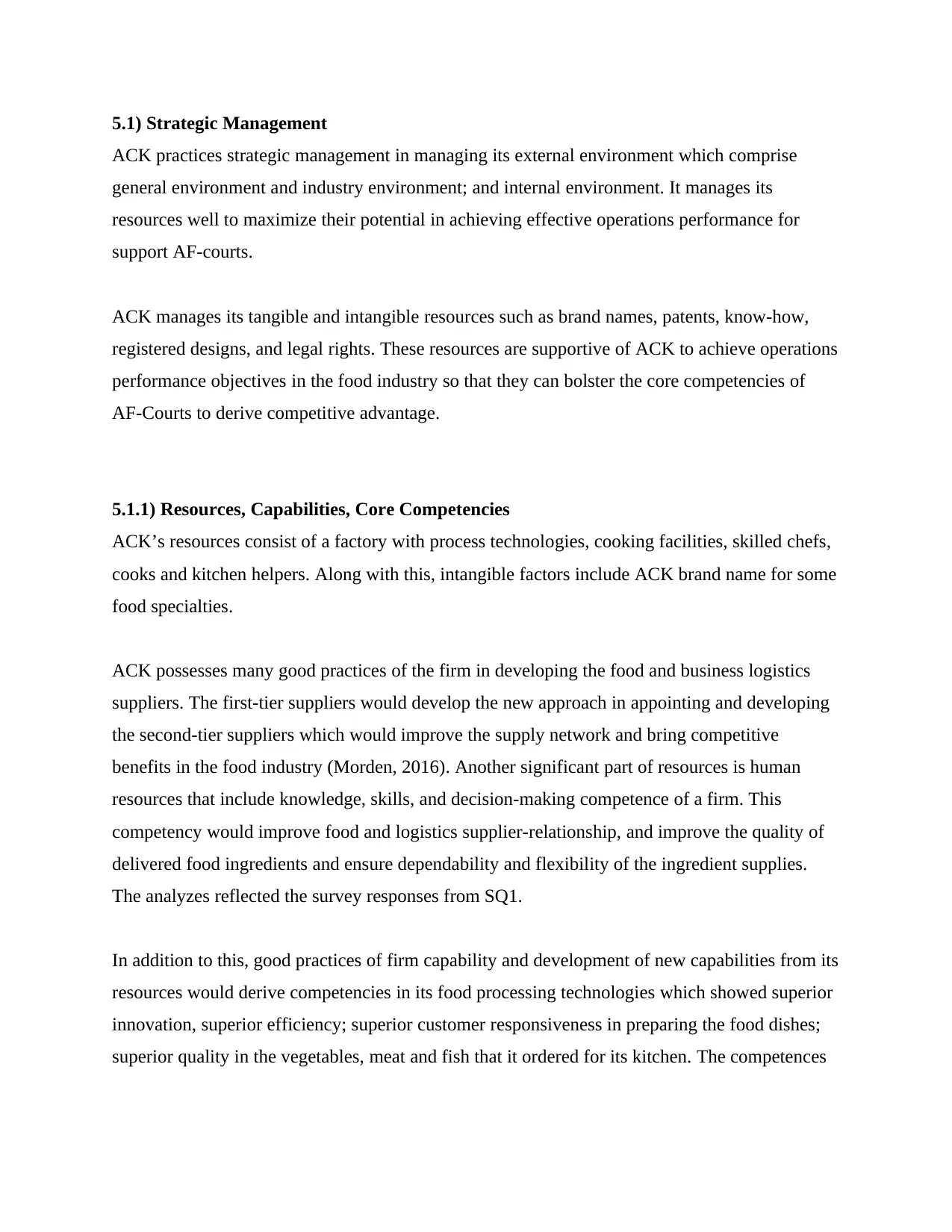
5.1) Strategic Management
ACK practices strategic management in managing its external environment which comprise
general environment and industry environment; and internal environment. It manages its
resources well to maximize their potential in achieving effective operations performance for
support AF-courts.
ACK manages its tangible and intangible resources such as brand names, patents, know-how,
registered designs, and legal rights. These resources are supportive of ACK to achieve operations
performance objectives in the food industry so that they can bolster the core competencies of
AF-Courts to derive competitive advantage.
5.1.1) Resources, Capabilities, Core Competencies
ACK’s resources consist of a factory with process technologies, cooking facilities, skilled chefs,
cooks and kitchen helpers. Along with this, intangible factors include ACK brand name for some
food specialties.
ACK possesses many good practices of the firm in developing the food and business logistics
suppliers. The first-tier suppliers would develop the new approach in appointing and developing
the second-tier suppliers which would improve the supply network and bring competitive
benefits in the food industry (Morden, 2016). Another significant part of resources is human
resources that include knowledge, skills, and decision-making competence of a firm. This
competency would improve food and logistics supplier-relationship, and improve the quality of
delivered food ingredients and ensure dependability and flexibility of the ingredient supplies.
The analyzes reflected the survey responses from SQ1.
In addition to this, good practices of firm capability and development of new capabilities from its
resources would derive competencies in its food processing technologies which showed superior
innovation, superior efficiency; superior customer responsiveness in preparing the food dishes;
superior quality in the vegetables, meat and fish that it ordered for its kitchen. The competences
ACK practices strategic management in managing its external environment which comprise
general environment and industry environment; and internal environment. It manages its
resources well to maximize their potential in achieving effective operations performance for
support AF-courts.
ACK manages its tangible and intangible resources such as brand names, patents, know-how,
registered designs, and legal rights. These resources are supportive of ACK to achieve operations
performance objectives in the food industry so that they can bolster the core competencies of
AF-Courts to derive competitive advantage.
5.1.1) Resources, Capabilities, Core Competencies
ACK’s resources consist of a factory with process technologies, cooking facilities, skilled chefs,
cooks and kitchen helpers. Along with this, intangible factors include ACK brand name for some
food specialties.
ACK possesses many good practices of the firm in developing the food and business logistics
suppliers. The first-tier suppliers would develop the new approach in appointing and developing
the second-tier suppliers which would improve the supply network and bring competitive
benefits in the food industry (Morden, 2016). Another significant part of resources is human
resources that include knowledge, skills, and decision-making competence of a firm. This
competency would improve food and logistics supplier-relationship, and improve the quality of
delivered food ingredients and ensure dependability and flexibility of the ingredient supplies.
The analyzes reflected the survey responses from SQ1.
In addition to this, good practices of firm capability and development of new capabilities from its
resources would derive competencies in its food processing technologies which showed superior
innovation, superior efficiency; superior customer responsiveness in preparing the food dishes;
superior quality in the vegetables, meat and fish that it ordered for its kitchen. The competences
Paraphrase This Document
Need a fresh take? Get an instant paraphrase of this document with our AI Paraphraser
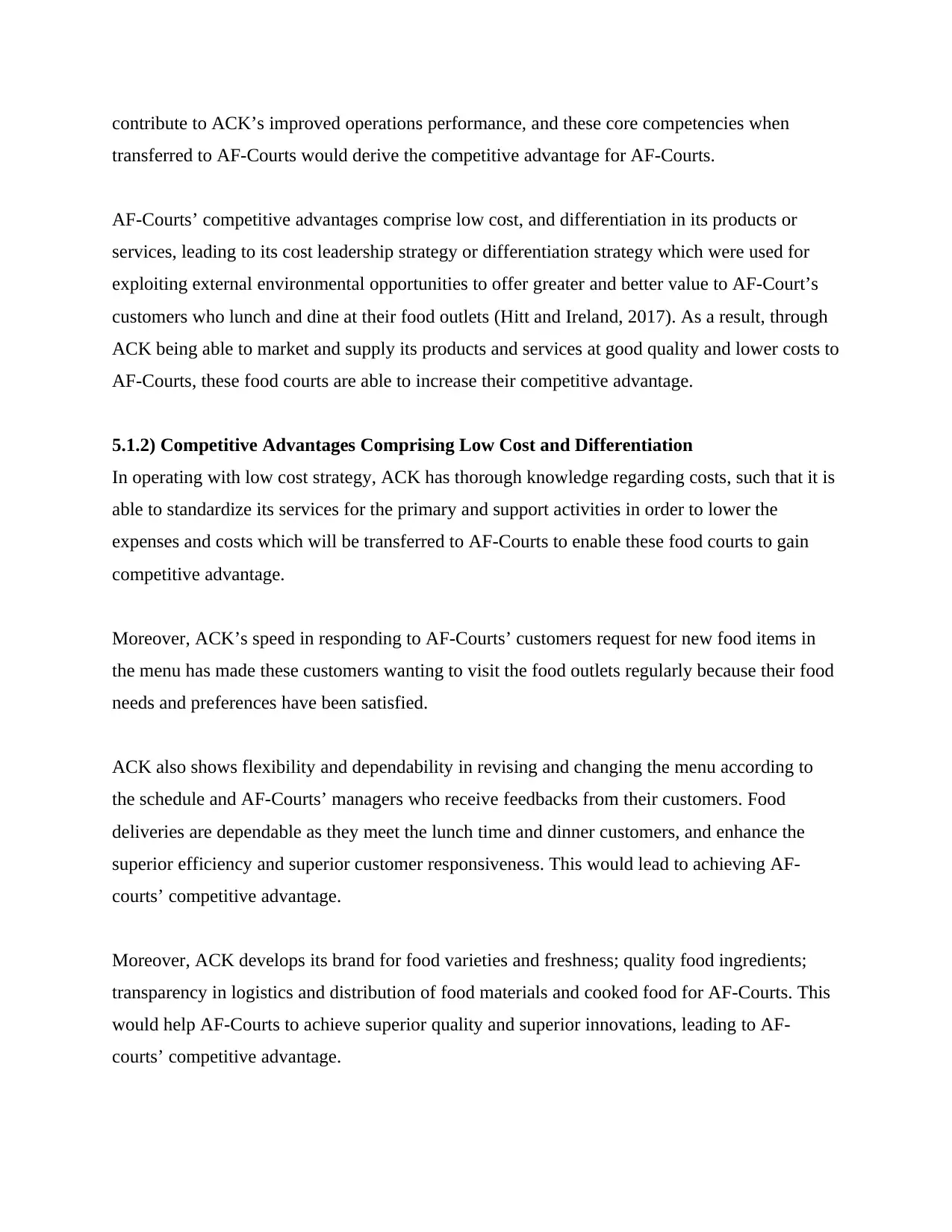
contribute to ACK’s improved operations performance, and these core competencies when
transferred to AF-Courts would derive the competitive advantage for AF-Courts.
AF-Courts’ competitive advantages comprise low cost, and differentiation in its products or
services, leading to its cost leadership strategy or differentiation strategy which were used for
exploiting external environmental opportunities to offer greater and better value to AF-Court’s
customers who lunch and dine at their food outlets (Hitt and Ireland, 2017). As a result, through
ACK being able to market and supply its products and services at good quality and lower costs to
AF-Courts, these food courts are able to increase their competitive advantage.
5.1.2) Competitive Advantages Comprising Low Cost and Differentiation
In operating with low cost strategy, ACK has thorough knowledge regarding costs, such that it is
able to standardize its services for the primary and support activities in order to lower the
expenses and costs which will be transferred to AF-Courts to enable these food courts to gain
competitive advantage.
Moreover, ACK’s speed in responding to AF-Courts’ customers request for new food items in
the menu has made these customers wanting to visit the food outlets regularly because their food
needs and preferences have been satisfied.
ACK also shows flexibility and dependability in revising and changing the menu according to
the schedule and AF-Courts’ managers who receive feedbacks from their customers. Food
deliveries are dependable as they meet the lunch time and dinner customers, and enhance the
superior efficiency and superior customer responsiveness. This would lead to achieving AF-
courts’ competitive advantage.
Moreover, ACK develops its brand for food varieties and freshness; quality food ingredients;
transparency in logistics and distribution of food materials and cooked food for AF-Courts. This
would help AF-Courts to achieve superior quality and superior innovations, leading to AF-
courts’ competitive advantage.
transferred to AF-Courts would derive the competitive advantage for AF-Courts.
AF-Courts’ competitive advantages comprise low cost, and differentiation in its products or
services, leading to its cost leadership strategy or differentiation strategy which were used for
exploiting external environmental opportunities to offer greater and better value to AF-Court’s
customers who lunch and dine at their food outlets (Hitt and Ireland, 2017). As a result, through
ACK being able to market and supply its products and services at good quality and lower costs to
AF-Courts, these food courts are able to increase their competitive advantage.
5.1.2) Competitive Advantages Comprising Low Cost and Differentiation
In operating with low cost strategy, ACK has thorough knowledge regarding costs, such that it is
able to standardize its services for the primary and support activities in order to lower the
expenses and costs which will be transferred to AF-Courts to enable these food courts to gain
competitive advantage.
Moreover, ACK’s speed in responding to AF-Courts’ customers request for new food items in
the menu has made these customers wanting to visit the food outlets regularly because their food
needs and preferences have been satisfied.
ACK also shows flexibility and dependability in revising and changing the menu according to
the schedule and AF-Courts’ managers who receive feedbacks from their customers. Food
deliveries are dependable as they meet the lunch time and dinner customers, and enhance the
superior efficiency and superior customer responsiveness. This would lead to achieving AF-
courts’ competitive advantage.
Moreover, ACK develops its brand for food varieties and freshness; quality food ingredients;
transparency in logistics and distribution of food materials and cooked food for AF-Courts. This
would help AF-Courts to achieve superior quality and superior innovations, leading to AF-
courts’ competitive advantage.
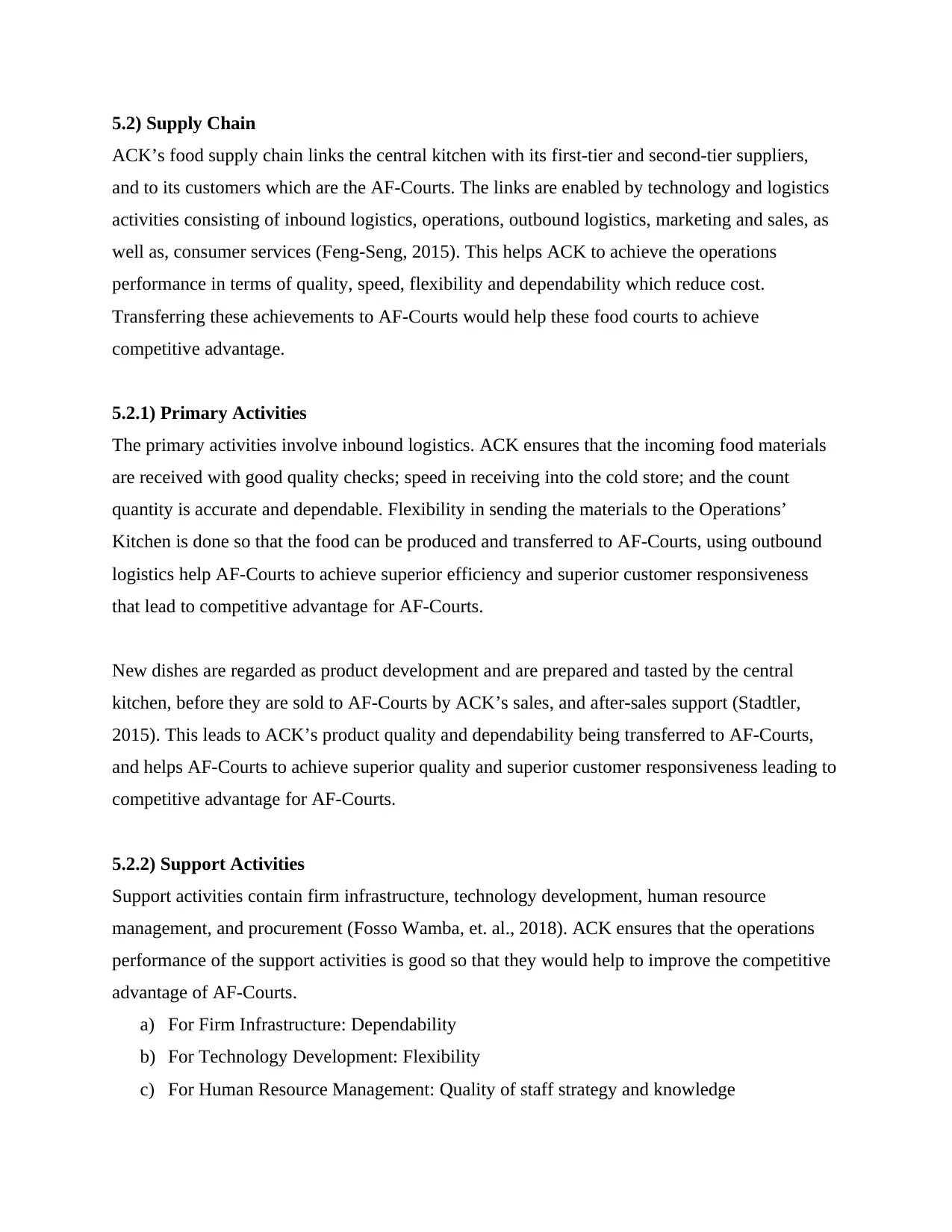
5.2) Supply Chain
ACK’s food supply chain links the central kitchen with its first-tier and second-tier suppliers,
and to its customers which are the AF-Courts. The links are enabled by technology and logistics
activities consisting of inbound logistics, operations, outbound logistics, marketing and sales, as
well as, consumer services (Feng-Seng, 2015). This helps ACK to achieve the operations
performance in terms of quality, speed, flexibility and dependability which reduce cost.
Transferring these achievements to AF-Courts would help these food courts to achieve
competitive advantage.
5.2.1) Primary Activities
The primary activities involve inbound logistics. ACK ensures that the incoming food materials
are received with good quality checks; speed in receiving into the cold store; and the count
quantity is accurate and dependable. Flexibility in sending the materials to the Operations’
Kitchen is done so that the food can be produced and transferred to AF-Courts, using outbound
logistics help AF-Courts to achieve superior efficiency and superior customer responsiveness
that lead to competitive advantage for AF-Courts.
New dishes are regarded as product development and are prepared and tasted by the central
kitchen, before they are sold to AF-Courts by ACK’s sales, and after-sales support (Stadtler,
2015). This leads to ACK’s product quality and dependability being transferred to AF-Courts,
and helps AF-Courts to achieve superior quality and superior customer responsiveness leading to
competitive advantage for AF-Courts.
5.2.2) Support Activities
Support activities contain firm infrastructure, technology development, human resource
management, and procurement (Fosso Wamba, et. al., 2018). ACK ensures that the operations
performance of the support activities is good so that they would help to improve the competitive
advantage of AF-Courts.
a) For Firm Infrastructure: Dependability
b) For Technology Development: Flexibility
c) For Human Resource Management: Quality of staff strategy and knowledge
ACK’s food supply chain links the central kitchen with its first-tier and second-tier suppliers,
and to its customers which are the AF-Courts. The links are enabled by technology and logistics
activities consisting of inbound logistics, operations, outbound logistics, marketing and sales, as
well as, consumer services (Feng-Seng, 2015). This helps ACK to achieve the operations
performance in terms of quality, speed, flexibility and dependability which reduce cost.
Transferring these achievements to AF-Courts would help these food courts to achieve
competitive advantage.
5.2.1) Primary Activities
The primary activities involve inbound logistics. ACK ensures that the incoming food materials
are received with good quality checks; speed in receiving into the cold store; and the count
quantity is accurate and dependable. Flexibility in sending the materials to the Operations’
Kitchen is done so that the food can be produced and transferred to AF-Courts, using outbound
logistics help AF-Courts to achieve superior efficiency and superior customer responsiveness
that lead to competitive advantage for AF-Courts.
New dishes are regarded as product development and are prepared and tasted by the central
kitchen, before they are sold to AF-Courts by ACK’s sales, and after-sales support (Stadtler,
2015). This leads to ACK’s product quality and dependability being transferred to AF-Courts,
and helps AF-Courts to achieve superior quality and superior customer responsiveness leading to
competitive advantage for AF-Courts.
5.2.2) Support Activities
Support activities contain firm infrastructure, technology development, human resource
management, and procurement (Fosso Wamba, et. al., 2018). ACK ensures that the operations
performance of the support activities is good so that they would help to improve the competitive
advantage of AF-Courts.
a) For Firm Infrastructure: Dependability
b) For Technology Development: Flexibility
c) For Human Resource Management: Quality of staff strategy and knowledge
⊘ This is a preview!⊘
Do you want full access?
Subscribe today to unlock all pages.

Trusted by 1+ million students worldwide
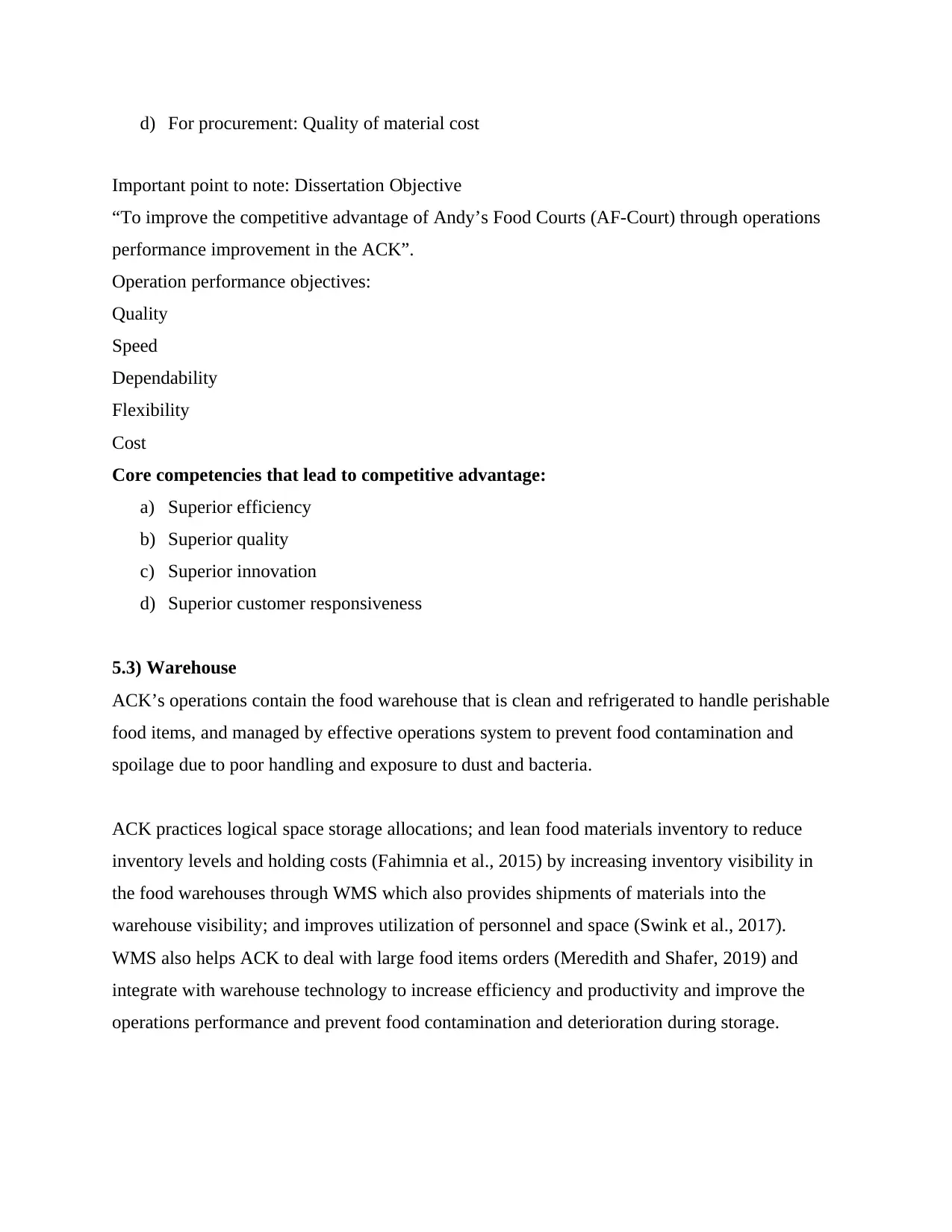
d) For procurement: Quality of material cost
Important point to note: Dissertation Objective
“To improve the competitive advantage of Andy’s Food Courts (AF-Court) through operations
performance improvement in the ACK”.
Operation performance objectives:
Quality
Speed
Dependability
Flexibility
Cost
Core competencies that lead to competitive advantage:
a) Superior efficiency
b) Superior quality
c) Superior innovation
d) Superior customer responsiveness
5.3) Warehouse
ACK’s operations contain the food warehouse that is clean and refrigerated to handle perishable
food items, and managed by effective operations system to prevent food contamination and
spoilage due to poor handling and exposure to dust and bacteria.
ACK practices logical space storage allocations; and lean food materials inventory to reduce
inventory levels and holding costs (Fahimnia et al., 2015) by increasing inventory visibility in
the food warehouses through WMS which also provides shipments of materials into the
warehouse visibility; and improves utilization of personnel and space (Swink et al., 2017).
WMS also helps ACK to deal with large food items orders (Meredith and Shafer, 2019) and
integrate with warehouse technology to increase efficiency and productivity and improve the
operations performance and prevent food contamination and deterioration during storage.
Important point to note: Dissertation Objective
“To improve the competitive advantage of Andy’s Food Courts (AF-Court) through operations
performance improvement in the ACK”.
Operation performance objectives:
Quality
Speed
Dependability
Flexibility
Cost
Core competencies that lead to competitive advantage:
a) Superior efficiency
b) Superior quality
c) Superior innovation
d) Superior customer responsiveness
5.3) Warehouse
ACK’s operations contain the food warehouse that is clean and refrigerated to handle perishable
food items, and managed by effective operations system to prevent food contamination and
spoilage due to poor handling and exposure to dust and bacteria.
ACK practices logical space storage allocations; and lean food materials inventory to reduce
inventory levels and holding costs (Fahimnia et al., 2015) by increasing inventory visibility in
the food warehouses through WMS which also provides shipments of materials into the
warehouse visibility; and improves utilization of personnel and space (Swink et al., 2017).
WMS also helps ACK to deal with large food items orders (Meredith and Shafer, 2019) and
integrate with warehouse technology to increase efficiency and productivity and improve the
operations performance and prevent food contamination and deterioration during storage.
Paraphrase This Document
Need a fresh take? Get an instant paraphrase of this document with our AI Paraphraser
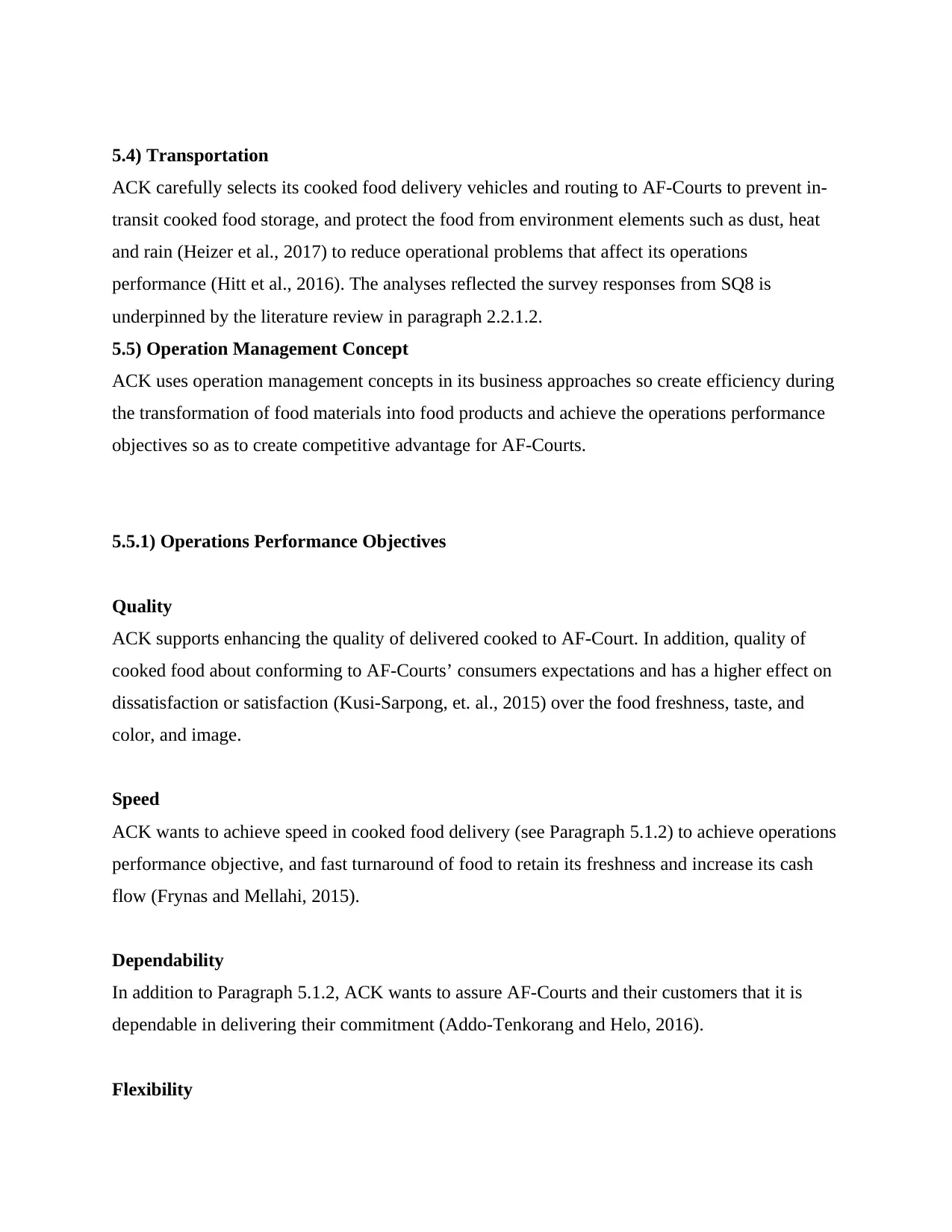
5.4) Transportation
ACK carefully selects its cooked food delivery vehicles and routing to AF-Courts to prevent in-
transit cooked food storage, and protect the food from environment elements such as dust, heat
and rain (Heizer et al., 2017) to reduce operational problems that affect its operations
performance (Hitt et al., 2016). The analyses reflected the survey responses from SQ8 is
underpinned by the literature review in paragraph 2.2.1.2.
5.5) Operation Management Concept
ACK uses operation management concepts in its business approaches so create efficiency during
the transformation of food materials into food products and achieve the operations performance
objectives so as to create competitive advantage for AF-Courts.
5.5.1) Operations Performance Objectives
Quality
ACK supports enhancing the quality of delivered cooked to AF-Court. In addition, quality of
cooked food about conforming to AF-Courts’ consumers expectations and has a higher effect on
dissatisfaction or satisfaction (Kusi-Sarpong, et. al., 2015) over the food freshness, taste, and
color, and image.
Speed
ACK wants to achieve speed in cooked food delivery (see Paragraph 5.1.2) to achieve operations
performance objective, and fast turnaround of food to retain its freshness and increase its cash
flow (Frynas and Mellahi, 2015).
Dependability
In addition to Paragraph 5.1.2, ACK wants to assure AF-Courts and their customers that it is
dependable in delivering their commitment (Addo-Tenkorang and Helo, 2016).
Flexibility
ACK carefully selects its cooked food delivery vehicles and routing to AF-Courts to prevent in-
transit cooked food storage, and protect the food from environment elements such as dust, heat
and rain (Heizer et al., 2017) to reduce operational problems that affect its operations
performance (Hitt et al., 2016). The analyses reflected the survey responses from SQ8 is
underpinned by the literature review in paragraph 2.2.1.2.
5.5) Operation Management Concept
ACK uses operation management concepts in its business approaches so create efficiency during
the transformation of food materials into food products and achieve the operations performance
objectives so as to create competitive advantage for AF-Courts.
5.5.1) Operations Performance Objectives
Quality
ACK supports enhancing the quality of delivered cooked to AF-Court. In addition, quality of
cooked food about conforming to AF-Courts’ consumers expectations and has a higher effect on
dissatisfaction or satisfaction (Kusi-Sarpong, et. al., 2015) over the food freshness, taste, and
color, and image.
Speed
ACK wants to achieve speed in cooked food delivery (see Paragraph 5.1.2) to achieve operations
performance objective, and fast turnaround of food to retain its freshness and increase its cash
flow (Frynas and Mellahi, 2015).
Dependability
In addition to Paragraph 5.1.2, ACK wants to assure AF-Courts and their customers that it is
dependable in delivering their commitment (Addo-Tenkorang and Helo, 2016).
Flexibility
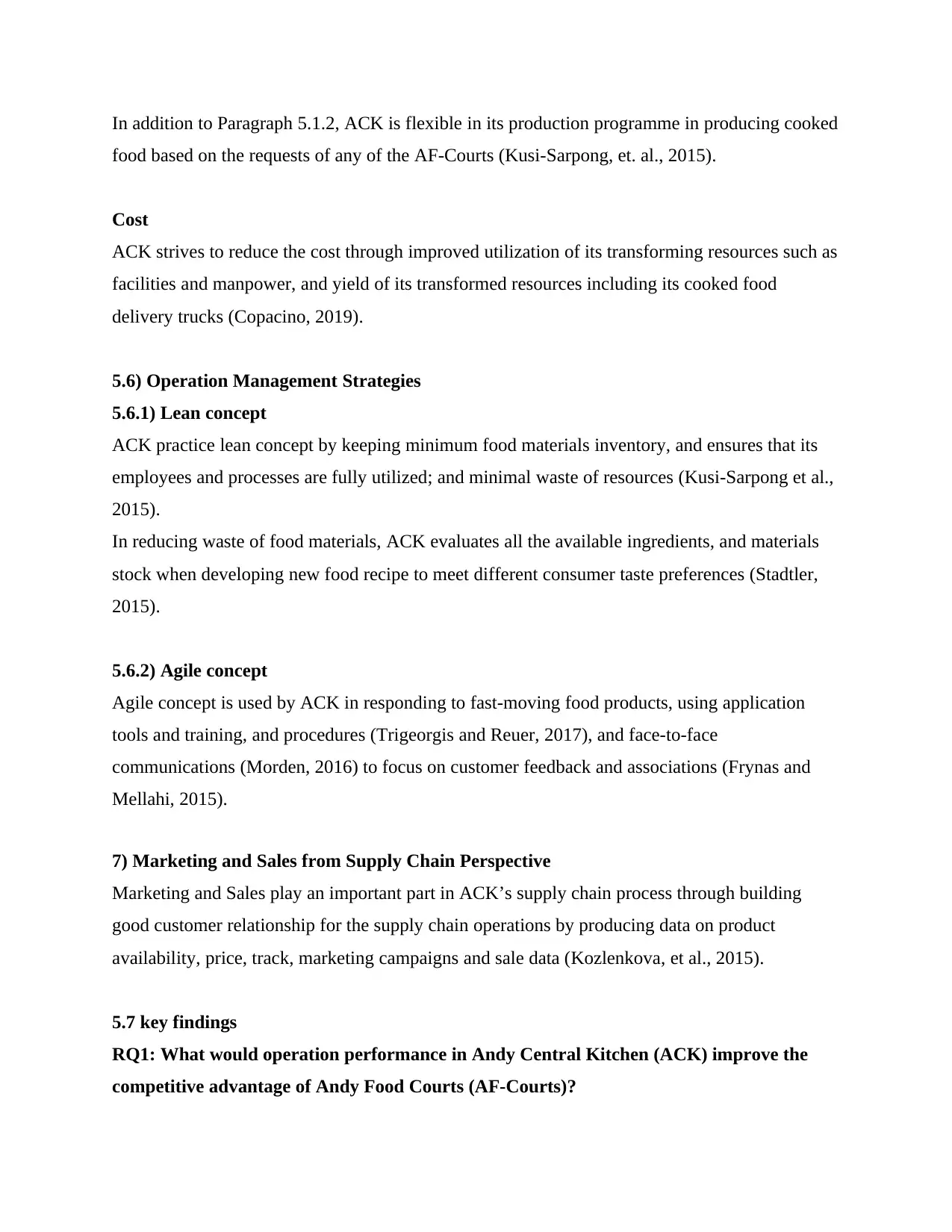
In addition to Paragraph 5.1.2, ACK is flexible in its production programme in producing cooked
food based on the requests of any of the AF-Courts (Kusi-Sarpong, et. al., 2015).
Cost
ACK strives to reduce the cost through improved utilization of its transforming resources such as
facilities and manpower, and yield of its transformed resources including its cooked food
delivery trucks (Copacino, 2019).
5.6) Operation Management Strategies
5.6.1) Lean concept
ACK practice lean concept by keeping minimum food materials inventory, and ensures that its
employees and processes are fully utilized; and minimal waste of resources (Kusi-Sarpong et al.,
2015).
In reducing waste of food materials, ACK evaluates all the available ingredients, and materials
stock when developing new food recipe to meet different consumer taste preferences (Stadtler,
2015).
5.6.2) Agile concept
Agile concept is used by ACK in responding to fast-moving food products, using application
tools and training, and procedures (Trigeorgis and Reuer, 2017), and face-to-face
communications (Morden, 2016) to focus on customer feedback and associations (Frynas and
Mellahi, 2015).
7) Marketing and Sales from Supply Chain Perspective
Marketing and Sales play an important part in ACK’s supply chain process through building
good customer relationship for the supply chain operations by producing data on product
availability, price, track, marketing campaigns and sale data (Kozlenkova, et al., 2015).
5.7 key findings
RQ1: What would operation performance in Andy Central Kitchen (ACK) improve the
competitive advantage of Andy Food Courts (AF-Courts)?
food based on the requests of any of the AF-Courts (Kusi-Sarpong, et. al., 2015).
Cost
ACK strives to reduce the cost through improved utilization of its transforming resources such as
facilities and manpower, and yield of its transformed resources including its cooked food
delivery trucks (Copacino, 2019).
5.6) Operation Management Strategies
5.6.1) Lean concept
ACK practice lean concept by keeping minimum food materials inventory, and ensures that its
employees and processes are fully utilized; and minimal waste of resources (Kusi-Sarpong et al.,
2015).
In reducing waste of food materials, ACK evaluates all the available ingredients, and materials
stock when developing new food recipe to meet different consumer taste preferences (Stadtler,
2015).
5.6.2) Agile concept
Agile concept is used by ACK in responding to fast-moving food products, using application
tools and training, and procedures (Trigeorgis and Reuer, 2017), and face-to-face
communications (Morden, 2016) to focus on customer feedback and associations (Frynas and
Mellahi, 2015).
7) Marketing and Sales from Supply Chain Perspective
Marketing and Sales play an important part in ACK’s supply chain process through building
good customer relationship for the supply chain operations by producing data on product
availability, price, track, marketing campaigns and sale data (Kozlenkova, et al., 2015).
5.7 key findings
RQ1: What would operation performance in Andy Central Kitchen (ACK) improve the
competitive advantage of Andy Food Courts (AF-Courts)?
⊘ This is a preview!⊘
Do you want full access?
Subscribe today to unlock all pages.

Trusted by 1+ million students worldwide
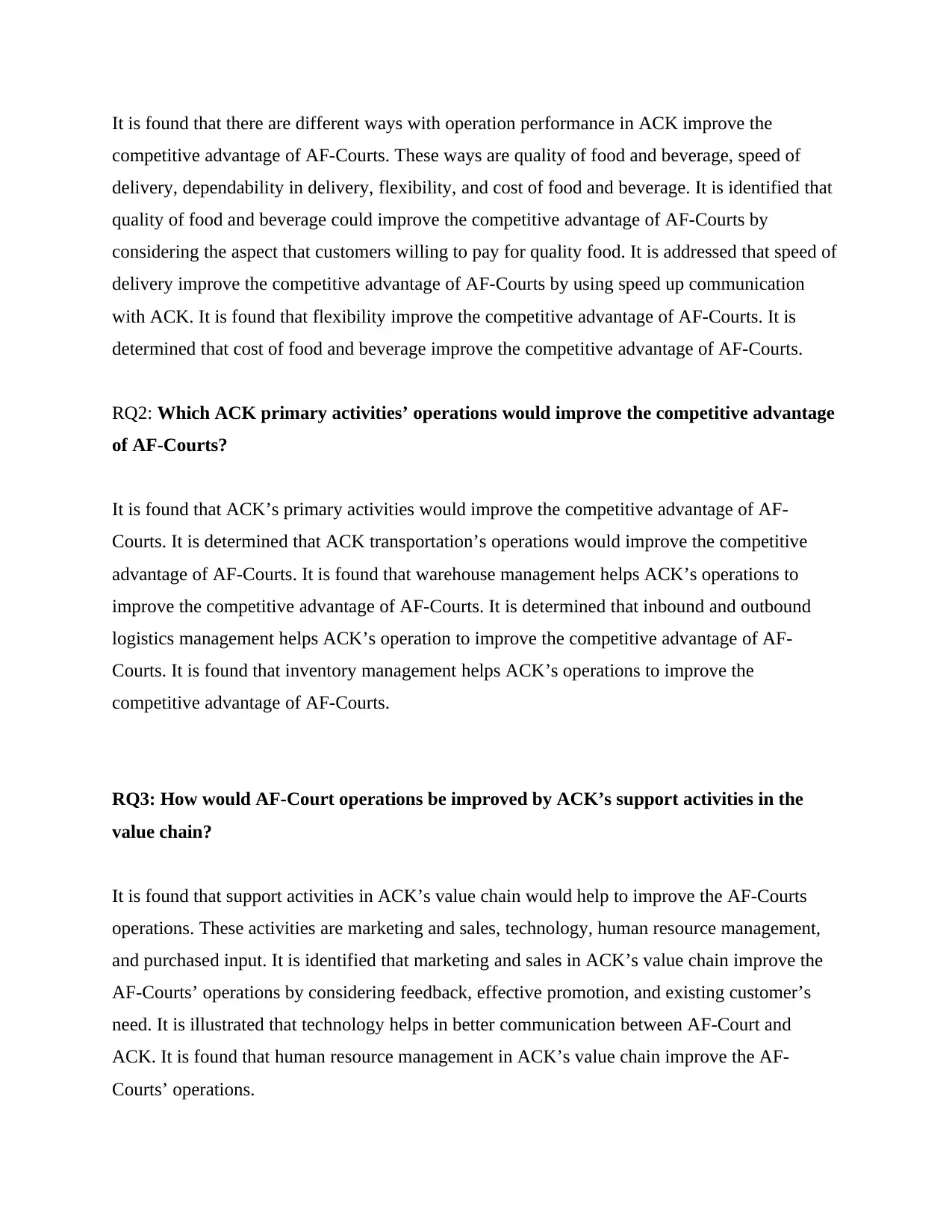
It is found that there are different ways with operation performance in ACK improve the
competitive advantage of AF-Courts. These ways are quality of food and beverage, speed of
delivery, dependability in delivery, flexibility, and cost of food and beverage. It is identified that
quality of food and beverage could improve the competitive advantage of AF-Courts by
considering the aspect that customers willing to pay for quality food. It is addressed that speed of
delivery improve the competitive advantage of AF-Courts by using speed up communication
with ACK. It is found that flexibility improve the competitive advantage of AF-Courts. It is
determined that cost of food and beverage improve the competitive advantage of AF-Courts.
RQ2: Which ACK primary activities’ operations would improve the competitive advantage
of AF-Courts?
It is found that ACK’s primary activities would improve the competitive advantage of AF-
Courts. It is determined that ACK transportation’s operations would improve the competitive
advantage of AF-Courts. It is found that warehouse management helps ACK’s operations to
improve the competitive advantage of AF-Courts. It is determined that inbound and outbound
logistics management helps ACK’s operation to improve the competitive advantage of AF-
Courts. It is found that inventory management helps ACK’s operations to improve the
competitive advantage of AF-Courts.
RQ3: How would AF-Court operations be improved by ACK’s support activities in the
value chain?
It is found that support activities in ACK’s value chain would help to improve the AF-Courts
operations. These activities are marketing and sales, technology, human resource management,
and purchased input. It is identified that marketing and sales in ACK’s value chain improve the
AF-Courts’ operations by considering feedback, effective promotion, and existing customer’s
need. It is illustrated that technology helps in better communication between AF-Court and
ACK. It is found that human resource management in ACK’s value chain improve the AF-
Courts’ operations.
competitive advantage of AF-Courts. These ways are quality of food and beverage, speed of
delivery, dependability in delivery, flexibility, and cost of food and beverage. It is identified that
quality of food and beverage could improve the competitive advantage of AF-Courts by
considering the aspect that customers willing to pay for quality food. It is addressed that speed of
delivery improve the competitive advantage of AF-Courts by using speed up communication
with ACK. It is found that flexibility improve the competitive advantage of AF-Courts. It is
determined that cost of food and beverage improve the competitive advantage of AF-Courts.
RQ2: Which ACK primary activities’ operations would improve the competitive advantage
of AF-Courts?
It is found that ACK’s primary activities would improve the competitive advantage of AF-
Courts. It is determined that ACK transportation’s operations would improve the competitive
advantage of AF-Courts. It is found that warehouse management helps ACK’s operations to
improve the competitive advantage of AF-Courts. It is determined that inbound and outbound
logistics management helps ACK’s operation to improve the competitive advantage of AF-
Courts. It is found that inventory management helps ACK’s operations to improve the
competitive advantage of AF-Courts.
RQ3: How would AF-Court operations be improved by ACK’s support activities in the
value chain?
It is found that support activities in ACK’s value chain would help to improve the AF-Courts
operations. These activities are marketing and sales, technology, human resource management,
and purchased input. It is identified that marketing and sales in ACK’s value chain improve the
AF-Courts’ operations by considering feedback, effective promotion, and existing customer’s
need. It is illustrated that technology helps in better communication between AF-Court and
ACK. It is found that human resource management in ACK’s value chain improve the AF-
Courts’ operations.
Paraphrase This Document
Need a fresh take? Get an instant paraphrase of this document with our AI Paraphraser
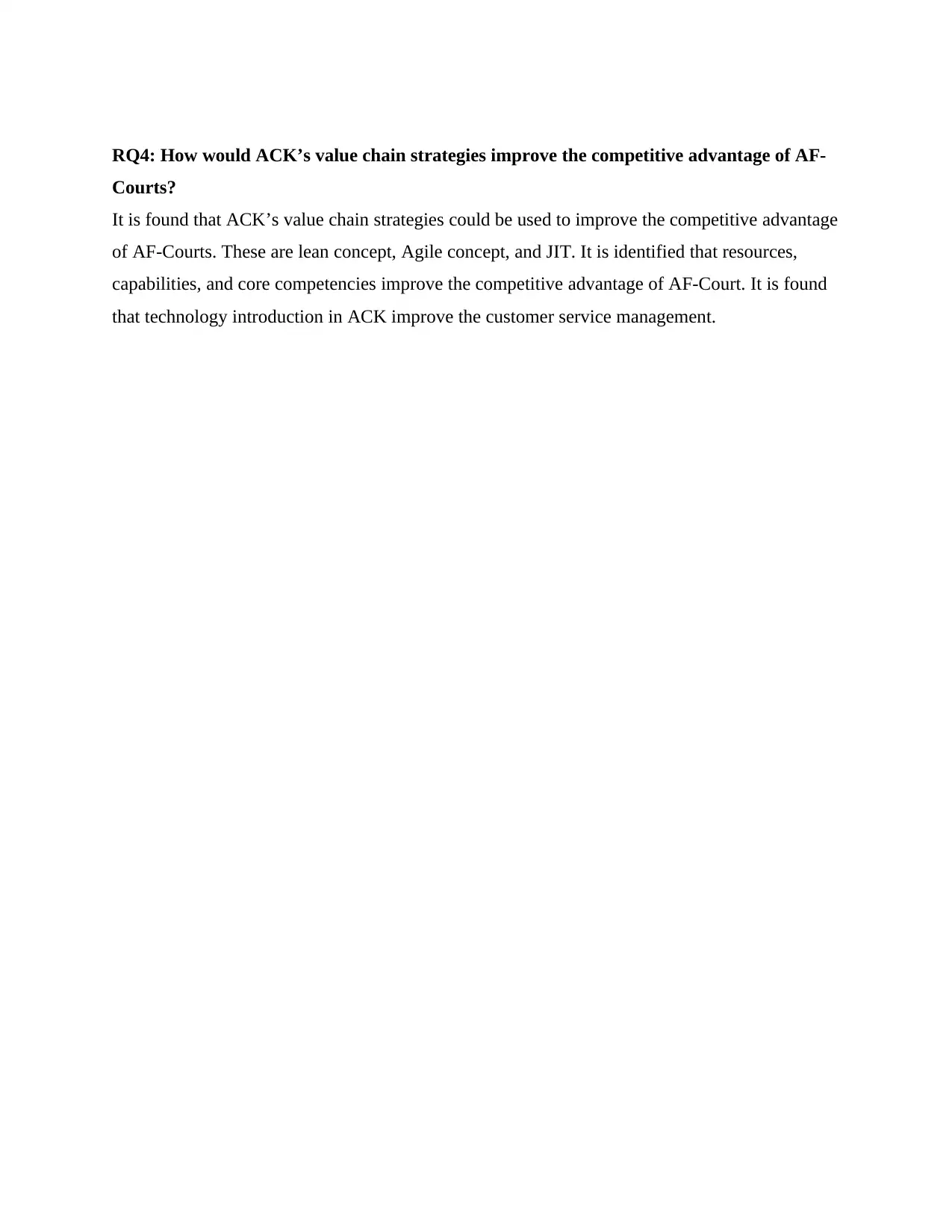
RQ4: How would ACK’s value chain strategies improve the competitive advantage of AF-
Courts?
It is found that ACK’s value chain strategies could be used to improve the competitive advantage
of AF-Courts. These are lean concept, Agile concept, and JIT. It is identified that resources,
capabilities, and core competencies improve the competitive advantage of AF-Court. It is found
that technology introduction in ACK improve the customer service management.
Courts?
It is found that ACK’s value chain strategies could be used to improve the competitive advantage
of AF-Courts. These are lean concept, Agile concept, and JIT. It is identified that resources,
capabilities, and core competencies improve the competitive advantage of AF-Court. It is found
that technology introduction in ACK improve the customer service management.
1 out of 8
Related Documents
Your All-in-One AI-Powered Toolkit for Academic Success.
+13062052269
info@desklib.com
Available 24*7 on WhatsApp / Email
![[object Object]](/_next/static/media/star-bottom.7253800d.svg)
Unlock your academic potential
Copyright © 2020–2025 A2Z Services. All Rights Reserved. Developed and managed by ZUCOL.





